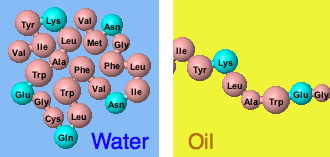High school teachers' resources
From Proteopedia
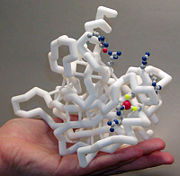
Physical model designed by a SMART Team.
Below are listed resources for high school (secondary school) teachers that concern 3D macromolecular structure, both within Proteopedia and outside it. High school teachers typically teach students of ages about 14-18. Some of the resources listed here are also appropriate for younger students (K-12), or older students including adults.
| HighSchool.MolviZ.Org brings you here! |
Macromolecules for High School Curricula
These molecules fit nicely into most secondary school biology curricula.
| Molecule | At BioMolecular Explorer 3D | At Molecule of the Month | At Proteopedia | See Also |
|---|---|---|---|---|
| Antibody | Antibody: Immune System | Antibodies | ||
| Collagen | Collagen: Connective Tissue | Collagen | ||
| DNA | DNA: Genetic Inheritance | DNA | DNA | |
| Hemoglobin | Hemoglobin: Respiration | Hemoglobin | Hemoglobin | |
| HIV Protease | HIV Protease: Infectious Diseases - AIDS Virus | HIV-1 Protease | HIV-1 Protease | |
| Lactase | Lactase: Digestion | (cf. Pepsin, | ||
| Lipid Bilayers | Lipid Bilayers and Channels: Cell Structure | Gramicidin Channel in Lipid Bilayer | ||
| Myosin | Myosin: A Molecular Motor | Myosin | ||
| Nucleosomes | Nucleosomes: Chromosome Structure | Nucleosome | Nucleosome |
Within Proteopedia
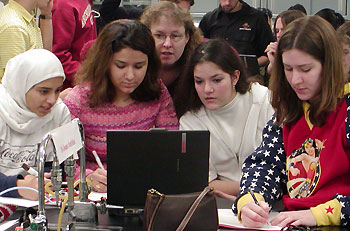
A SMART Team in action.
- About Macromolecular Structure lists articles that explain and define many macromolecular structure concepts, including biological units, hydrogen bonds, ligands, peptide, Protein Data Bank and PDB identification codes, and resolution.
- Importance of 3D macromolecular structure:
- Highest impact structures of all time.
- Structures saving the most lives.
- Molecular Workbench, ready-to-use discovery-based learning activities, at the high school level, with built-in assessment.
- High school students in California have coauthored articles mentored by Remo Rohs:
- SMART Teams consist of high school teachers and their students, collaborating with scientists to use rapid-prototyping technology to make 3D physical models of macromolecules. Recently, they are also making articles in Proteopedia, for example:
- Group:SMART:A Physical Model of the β2-Adrenergic Receptor, from the Madison West High School 2008 SMART Team.
- Teaching Scenes, Tutorials, and Educators' Pages, including
- Lac repressor with morphs of DNA being bent.
- Avian Influenza Neuraminidase, Tamiflu and Relenza
- Teaching Strategies Using Proteopedia
- Quizzes within Proteopedia
Outside Proteopedia
- Biomodel, 3D molecular visualization resources on many topics, also en español and other languages.
- BioMolecular Explorer 3D (bme3d.molviz.org). In addition to the molecules listed above, BME3D includes sections on carbohydrates, protein, lipids, vitamins, and water.
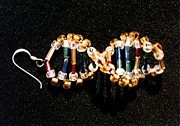
Earring representing the DNA double helix. Instructions available from Genetic Jewels.
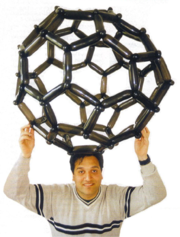
Carbon buckyball made with balloons. More at BalloonMolecules.com.
|

